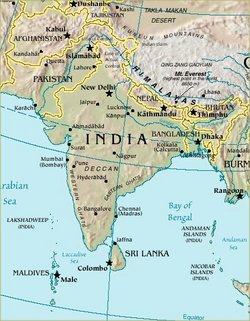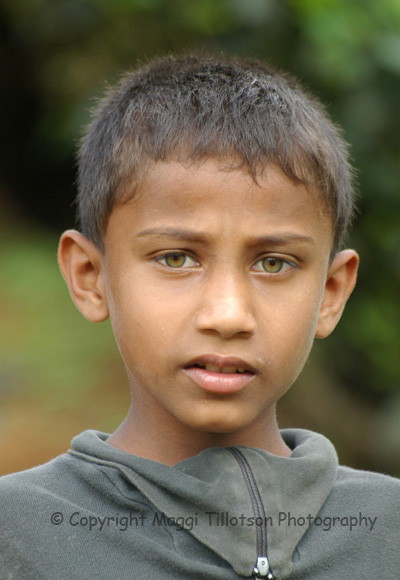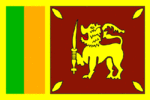Sri Lanka is an island nation, a former British Colony (Ceylon) located close to the southern tip of India. The sea separating Sri Lanka from India is extremely shallow and legends abound suggesting that at one time it was possible to wade across the Palk Strait by following the line of a chain of islands known as Adam’s Bridge. This proximity accounts for the similarities between the south Indian state of Tamil Nadu and the culturally and liguistically Tamil northern province of Sri Lanka.
Further to the south of Sri Lanka both the culture and language are distinctly different - Sinhalese. Between 1983 and 2009 these factions fought a civil war, the effects of which remain evident today.
The only religious motivations for circumcision occur amongst the Islamic minority, estimated to be 8% of the total population and concentrated on the east coast. Nationally, the majority religion is Buddhism.
 |
 |
Our local correspondent Imasha Karunaratne writes....
Sri Lanka is also known as the pearl of the Indian Ocean. The country has 9 Provinces and 25 administrative Districts. The population of the country is a little over 20 million, made up of 69% Buddhist, 8% Muslims and 7% Hindus, the remainder being Christians or other minority religious communities.
Circumcision in Sri Lanka goes back centuries to the time when Muslims first came to Sri Lanka. Presently the percentage of circumcised males is just above 7% which includes Muslims and others who are circumcised for medical reasons. Circumcision is considered a must by almost all the Muslims. The highest proportion of circumcised males in Sri Lanka are from the Eastern Province whilst the lowest incidence of circumcision is in the Southern and Uva Provinces.
 Age at Circumcision amongst the Muslims (only)
Age at Circumcision amongst the Muslims (only)
A century or so ago, in the early 1900s, Muslims carried out only ritual circumcision, done when the boy was between the ages of 13 and 16. Usually a mass circumcision was carried out once a year or once every two years. All the boys in the local area underwent circumcision together, which some people considered as a shift from childhood to adulthood.
This pattern continued in the Eastern Province, whilst from the 1950s a shift in the pattern in Central Province saw boys being circumcised between the ages of 11 and 15. In the rest of Sri Lanka the age dropped further, to between 10 and 14. However all the circumcision continued to be done in the ritual manner. At the same time the number of ceremonies per year showed a significant increase from 1 to around 4.
The 1980 era showed another change in circumcision. The age where a boy underwent circumcision continued to decline all around the country. In Eastern Province the norm became 8 to 12, in Central Province 6 to 10 and elsewhere around 5 to 10. There was a small but definite shift from the ritual circumcision to circumcision in hospital during this decade. Nevertheless most parents continued to opt for ritual circumcision since that’s how they underwent circumcision and they had severe resistance to change.
The 1990s saw few major changes relating to the development of healthcare facilities or communication. Nevertheless, a major shift away from ritual circumcision towards circumcision in hospital started at this time. Since 2000 very few boys undergo ritual circumcision although the traditional approach has not disappeared completely. A significant number of people are circumcising their children within 2 months of birth but circumcision at the later age is still in practice. A few people from the Eastern Province say that they prefer to carry out circumcision just before puberty thus allowing time for the penis to grow and the foreskin to grow completely so that the glans would be completely exposed after the circumcision.
"Ceylonese Boys", painting by Donald Friend (1915-1989).
CircumcisersEven though we have reached 2010, ritual circumcision is still practiced in Sri Lanka. “Oostha Mama” is the term describing the ritual circumciser in the colloquial language. Ritual circumcision can be seen in the Eastern Province, the district of Mannar, Puttalam and some places around Kandy. The tradition of being the Oostha Mama or ritual circumciser used to be handed down from generation to generation and considered to be an honour, but the new generation males did not show much interest and so the art of being an Oostha Mama is fading away.
The doctors do circumcisions every day. Mostly there is no need to get prior appointment for circumcision; it is simple as walking in and getting it done with a local anesthesia. Most of the doctors are males but there are a reasonable number of female doctors who only carry out circumcisions for infants.
Style of circumcision varies a lot in Sri Lanka. Basically both doctors and the Oostha Mamas are unaware that there are many styles of circumcision available. Most of the modern-day circumcision carried out by medical practitioners are Loose (or moderately tight) and High circumcisions whereas the circumcisions that were carried out in late 1980s and early 1990s by medical practitioners tended to be Loose and Low circumcisions. A medical practitioner rarely removes the frenulum. They are aware of partial circumcision but perform them only rarely.
Present day doctors use Gomco Clamp, Plastibell or Forceps Guided method to carry out the surgery. By contrast, during the late 1980s only the Forceps Guided method was used by doctors. Oostha Mamas carry out the circumcisions basically in two forms. The main method is to insert a stick inside the foreskin until it touches the glans. Then he would push the foreskin forward and slice the foreskin through the estimate from the stick which would provide the place where the glans begin. The second method is to push the foreskin forward and then have a barrier between the foreskin and the glans then slice off the foreskin at that place. The circumcisions by the Oostha Mama always results in High and Tight style.
Associated Social GatheringsA circumcision in the Muslim community is seen as an opportunity for a family get-together. Sri Lanka is a country where the people live and always associate with the extended family. Until the 1980s Muslims celebrated a circumcision with a feast where all the extended family members would come to the boy’s home and wish him good luck. After the circumcision the people who attended the circumcision would give gifts. Since the decline in the ritual circumcision, boys undergoing circumcisions at hospitals don’t get gifts. Circumcision is no longer a big party and it is done in private and at a very young age such that the boy is not capable of understanding what is happening around him.
In contrast, during the time of mass circumcisions everybody knew who the boys were that werere undergoing circumcision. People would wish them well and men attend the hall or the grounds to see the circumcision proceedings. If the ritual circumcisions are carried out at home the people attend the home, but then only on an invitational basis. The extended family will automatically be there since it is considered that they are anyway invited. In the case of home circumcisions, sometimes females will also witness the circumcision.
Forgotten CircumcisionMany Muslims who were from the Northern Province couldn’t arrange circumcisions for their children due to the war in the region. This basically created a lot of non-circumcised Muslims in one particular region in Sri Lanka. Few welfare organizations have funded doctors to carry out circumcisions for uncircumcised children in these regions.
Sri Lanka is also the host for the considerable amount of Muslims of Malay origin and most do circumcise according to the Muslim's norm. However some Malay Muslims don’t opt for circumcision of their children for various reasons and one main reason is due to inter-cultural marriages where one partner may be from the community in which they don’t circumcise.
Circumcision in non-Muslim Sri Lankan societyEven today people from the villages rarely know much about circumcision, whilst the urban population has a fair idea about the basics of circumcision including the procedure. Most of the people do think that circumcision is cutting of the penis at the corner or by half. This idea has led to a few nicknames for people who are circumcised, widely used in Sri Lanka. Examples are “Konakapala”, which derives from “Kona-kapala” meaning “The edge is cut” and “Thunkala” which means “Three Quarter” (inferring that the penis is not whole but only three quarters available).
Circumcision amongst the Non-Muslim population has shown an increasing trend due to various reasons. It is said that Sri Lankans along with men from other South Asian countries have longer foreskins compared to the rest of the world. In comparison to other countries penile cleanliness is low due to lack of knowledge and access to adequate bathing resources amongst the people. Men in Sri Lanka tend to have an above-average incidence of phimosis.
Infant and child circumcision is not popular but it is done when needed to treat problems in urinating. Some lady doctors pursue their spouses to get circumcised and circumcision is considered amongst the educated crowd who are aware of the problems an uncircumcised penis might cause in later life.
[Submitted January 2010]

Tea Boy, Sri Lanka, by Maggi Tillotson Photography, UK.
A Sri Lankan Surgeon's Story
I am a surgeon by profession living in Sri Lanka. As a school-girl most of my friends and I were under the impression that circumcision means cutting off the tip of the penis; which was probably the reason for many of our insider jokes. These jokes were usually made between us and our Islamic friends who would get a circumcised partner in their lives. Later, as I was pursuing my medical and surgical studies, was when I got an in-depth knowledge about circumcision. As I completed my surgical appointment, I developed an obsession about circumcision. I have personally assisted at, and conducted, multiple circumcisions, mostly for medical reasons such as phimosis and extra long foreskin; as I have heard that Sri Lankans tend to have extra long foreskins.
I never had any preference about my partners circumcision status. I always admired the appearance of the circumcised penis but never had a hardcore preference on the status.
My life went on as usual till I met my husband and got married. My husband had an extra long foreskin which would still hang over the tip of his penis even during a strong erection. His foreskin was approximately one and half inch long during an erection and probably longer than his penis when flaccid. Husbands foreskin was so long that it would kind of balloon when he urinates and he needed to squeeze out the urine every time after urinating. This usually bothered me and was a big interference in our sexual activities. He needs to pull his skin back and hold it when we have sex. When giving him a blow job I had to pull his skin to do the needful over his glans. No need to mention the bad smell it produced which was definitely a turn off. A few months went by and we started to explore different options. At one instance we tried pulling his foreskin back and hold it using a medical tape. This experiment turned out to be one of the best sexual experiences for both of us.
I would once in a while let my husband know that I do perform circumcisions. No matter what, he was dead scared to send his penis under the knife. It took me an year of argument, pillow talk, internet exploration and many sexual activities by holding his foreskin back to convince him that he has an extra long foreskin and he needs to be circumcised so that both of us will be able to enjoy our sexual life without the interference of his foreskin.
Once he agreed then the process of finding a suitable surgeon began, since it is unethical in the medical profession to do surgery on people who are close to you. I had to find a person soon enough before my husband could revert back to "no". Since I live in a city called Kandy with a very small number of surgeons I knew one of my colleagues who is a very experienced surgeon and has done many circumcisions. My husband was too shy to go to the hospital for a surgery or for any other place for that matter since everybody would know who he is and he would feel embarrassed. I had to convince my colleague for the surgery to be at her private clinic after hours, meaning only she will be present during the surgery along with my husband and myself.
Then we planned all the activities around his circumcision, from simple things like cleaning the home to his pubic area. Letting our relatives and parents know that we are out in order to avoid unexpected visitors arriving and see my husband having trouble walking and wondering what happened. Husband took time off from his work and I also took few days off to be around him and help him out. We enjoyed some intimate moments leading up to the circumcision including playing with his foreskin, foreskin torture, last sex with foreskin and obviously some pictures and videos of his foreskin as memorabilia.
On the day of the circumcision, we arrived at my colleagues clinic late night around 9pm. By this time my husband had ejaculated few times during the day, had a good shower, and was ready for circumcision. Upon arrival at the clinic she was waiting for our arrival and had everything ready. Soon after we arrived she put my husband on the bed and administered a local anesthetic. A few minutes passed and all of us were having some discussions while my husbands penis was getting numb. Then slowly my colleague started to do the circumcision procedure; obviously making it tight as much as possible according to my preference. Since she was doing it alone once in a while she would ask for my assistance. However, most of the time I would be with my husband standing next and talking to him so that he feels relaxed. My colleague would joke and she would keep talking to make the situation feel calm. However, she did mention that this is one of the longest foreskins she has seen and it is good that we decided on circumcision.
The whole procedure took about 30 mins and my husband's new penis was wrapped in a bandage. We left the clinic soon after, picked up some anti-erection pills and we were home just an hour after we actually left. It took about 2 weeks for him to completely heal. It was a more difficult wait for me than for my husband. The first few sex acts after the circumcision didn't go well as I had expected. My husband could not hold himself - even with my fingers touching his glans he would ejaculate all over. Within another 2 weeks he was able to hold himself and resumed normal activity. However, the sex felt extremely different with those deep thrusts and the movements he was able to make after circumcision. Previously it had been very light penetration and light thrust - now I understand what I had been missing for a year. Also with the foreskin gone the biggest interference to sex is gone which makes it more pleasing. I love giving him blow jobs and honestly it doesn't smell anymore.
Also the tight new look it gives to his penis makes me more aroused. I also feel that his glans looks better and bigger. Both of us agree that the circumcision was one of the best decisions we made. Following my husband's surgery, my colleague also got her husband circumcised. I also called upon one of my Muslim friends and confessed the fact that I got my husband circumcised and that I understand what I have been missing for a while and that she is lucky she won't know the difference in sex when it is uncircumcised.
While in Sri Lanka circumcision is mostly for Muslims, a small proportion of people do get circumcised due to medical reasons such as phimosis. However, people need to understand the medical benefits and sexual benefits it gives and consider this as an option given most of the people have longer foreskins.This will not only help for good sex but will also help in reducing cases of urinary infections.
DN, July 2017
Acknowledgements
The following resources were used in the preparation of this web page:
Personal testimony of contributors to Circlist.
Maps courtesy of the US State Department and Geology.com.

